Behind a Winning Shot
By Alan Krakauer
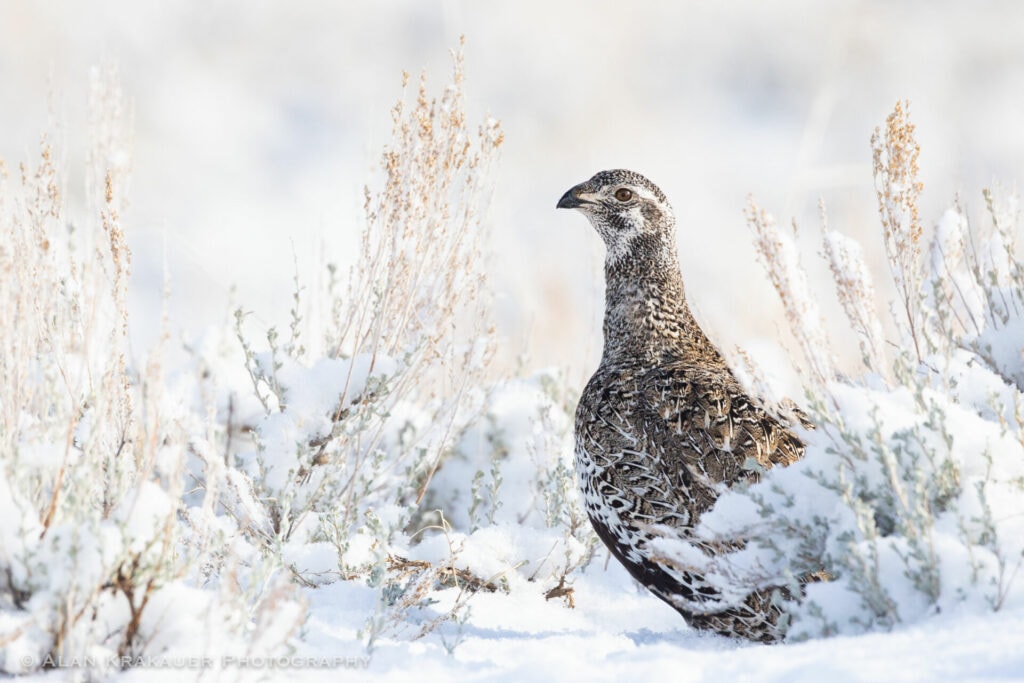
By now you may have seen the winners of the 2022 Audubon Photography Awards. Given the ever-expanding ranks of excellent bird photographers, I had no expectation of winning anything when I submitted three photos this spring. I had entered a few times in the past, and with the exception of a photo of roosting Marbled Godwits at Arrowhead Marsh that made the Top 100 in 2019, I’d not had any luck. I was just happy my entry fees were going to a great organization. You can imagine my shock when a representative from the National Audubon Society called to tell me my photo of a Greater Greater Sage-Grouse hen took home the “Female Bird” prize!
The story of the shot itself is doubtlessly similar to many other photographs recognized by Audubon through the years. Like most, it’s a variation of ‘photographer gets up early, waits patiently in unpleasant weather for birds to appear, magic happens.’
In my case, the magic happened in central Wyoming. My day started well before sunrise carefully navigating a snow-covered gravel track into sagebrush country. Parking on the shoulder in a remote valley, I switched on my headlamp, hoisted my backpack and thermos of coffee and trudged through several inches of snow. Eventually I reached my destination and my headlamp beam swept across the photography blind that would be my home for the next several hours. The fabric blind was already staked in place so it was just a matter of popping it up (not always easy when the pieces were frozen!), opening a couple of view flaps, and waiting in the pre-dawn chill for the first Greater Sage-Grouse to arrive.
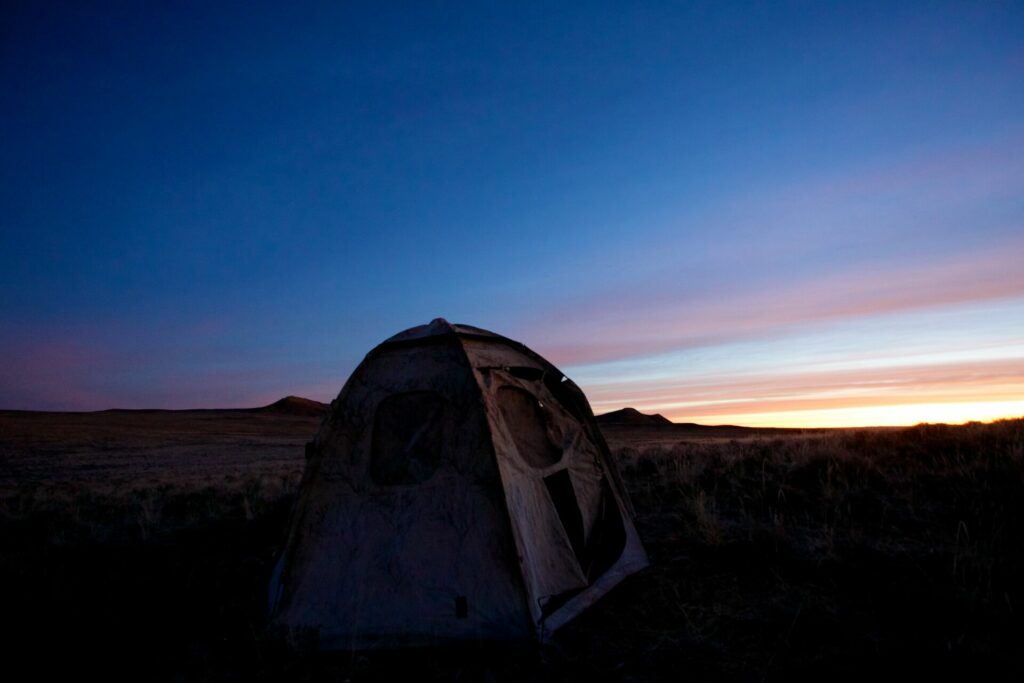
In the spring, Greater Sage-Grouse and other prairie grouse congregate on traditional display grounds called leks, a term that is used both for the groups of animals and the spot of land they use. These leks are extremely vulnerable to disturbance – one golden eagle zipping by or person walking up could scare all the birds away for the day and repeated disruptions could cause them to abandon the area completely. What is a photographer to do? Temporary blinds are small fabric tents that can hide wildlife watchers and their gear in view of a lek or other area of interest. The one I settled into that morning was hexagonal in shape and about five feet
tall, and had adjustable windows so I could show as little as possible to the outside world. (Please contact California Department of Fish and Game or other relevant wildlife management agency for other regulations and best practices for viewing Greater Sage-grouse up close).
Mid-march is peak breeding season in this area and before long the clearing in the sagebrush in front of the blind bustled with activity. The variety of sounds emerging from the males was captivating: coos, pops, swishes and guttural yammering, punctuated by the loud thuds of males striking each other with their wings in combat. A series of staccato quack-like calls streaming overhead heralded the arrival of females landing nearby.

As it grew brighter, all this activity slowly came into view. Males strutting for females, yellow vocal sacs emerging while their wings brushed against bristly breast feathers. When not displaying, males would waddle or run towards each other, locking in staring contests that often escalated to fights that kicked up clouds of snow. Yearling males without territories skirted around the males’ territories and were vigorously driven off if they drew too much attention.
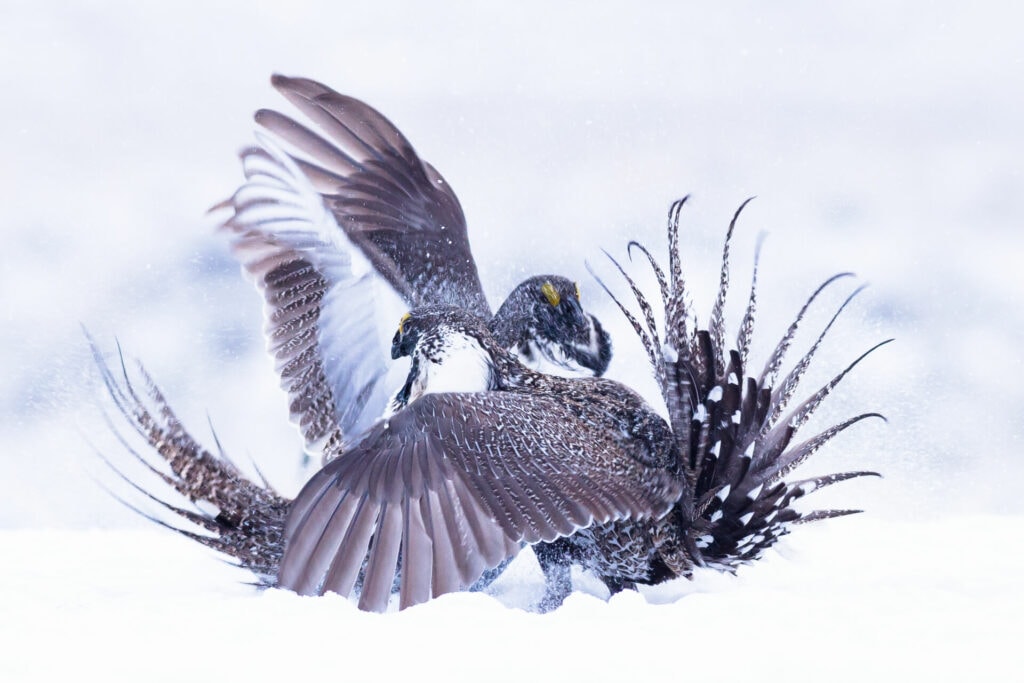
In the midst of all this pageantry, hens nonchalantly wandered around the males. Many appeared to casually preen or peck at the ground. Some were more serious about courtship. You could spot this happening when a hen gave the characteristic mate solicitation display –body lowered, wings spread with primaries splayed almost finger-like on the ground. There were even several copulations that day!
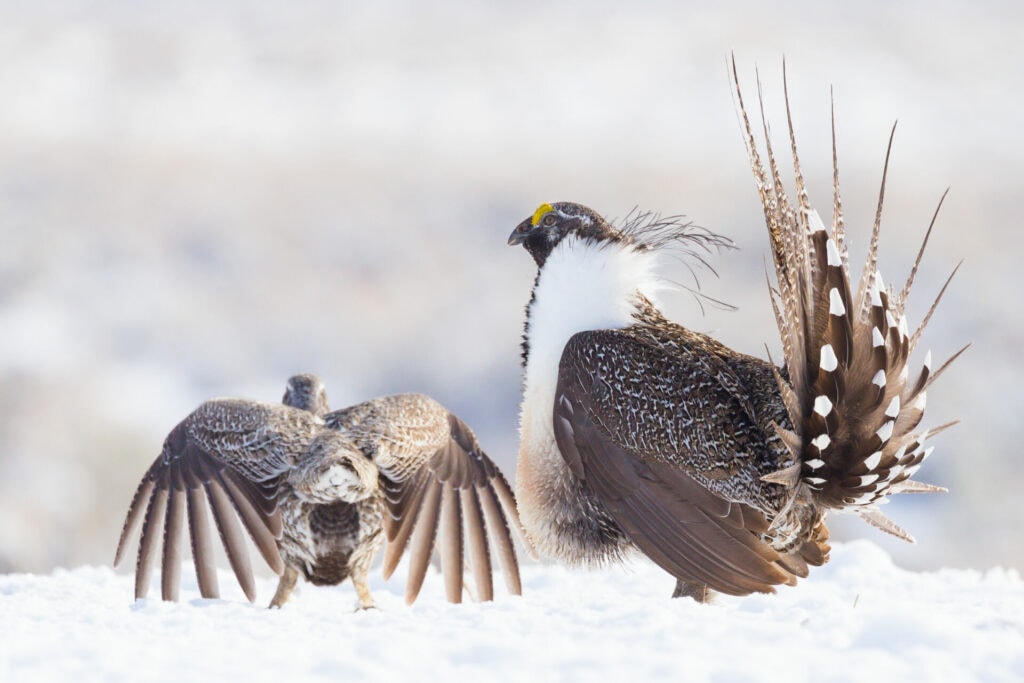
When a hen finished her business or took a break from the clamoring suitors, she sought some personal space in the sagebrush surrounding the lek. That’s where I caught sight of this female nibbling sage leaves. The morning sun bounced beautifully off the snow to put her in gorgeous light. She was close enough to the blind that I could really appreciate the fine patterning in her feathers. It may be surprising that from a morning with a lot of great dynamic photos of male Greater Sage-Grouse, my favorite was of a female standing calmly between two sagebrush plants.
That’s the tale of the shot! However, there’s more to the story of why I was there in Central Wyoming, trudging through the snow in the pre-dawn darkness. As I shared with GGBA several years ago (please see my archived version if you’d like to see the photos and video), Greater Sage-Grouse were much more than just photographic subjects to me.
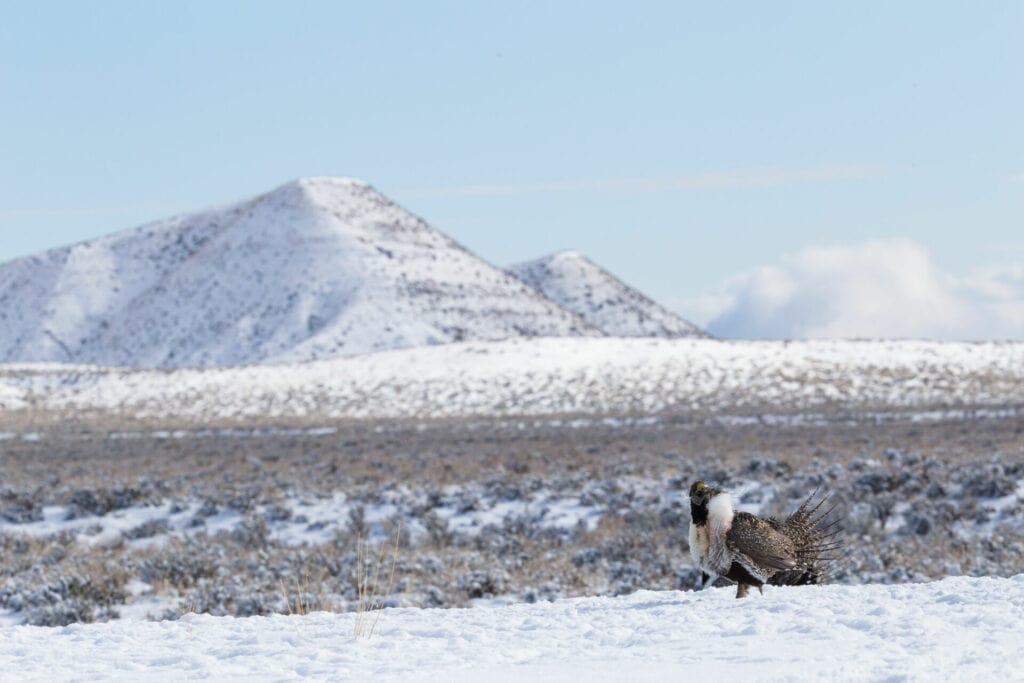
In 2016 I was working as a biologist and lecturer studying Greater Sage-Grouse at the University of California at Davis with Professor Gail Patricelli, her graduate students, and collaborators. Greater Sage-Grouse are more than just great photo subjects. Their lek breeding system and elaborate courtship have drawn researchers interested in learning about animal behavior and evolution. At the same time, numerous threats to this species and its fragile sagebrush habitat have made it a high-profile focus for land managers and conservationists in the West. To keep this article short, I won’t try to cover the details of our research here. Instead, I invite you to read more either on my website or Dr. Patricelli’s lab page. (spoiler alert: there are robot birds involved!)
Bringing this back to the image of the female Greater Sage-Grouse standing between two snow-draped sagebrush plants, photography proved to be an irreplaceable tool for us. Shots like my contest winner help set the scene when we shared our research. These are not birds you’re likely to see at your feeder or local park, and even if you are lucky enough visit the appropriate habitat it takes planning to see the lekking behavior in person. What do Greater Sage-Grouse actually look like? What is it like to experience a cold March morning in such a remote part of our country? Photos like this one help tell the story.
More than that, photography became a necessary step for collecting and interpreting our data. We needed to track what each male Greater Sage-Grouse was up to on different days. Where was he on the lek? How did he react in different phases of our experiments? How many times did he mate over the entire season? Ornithologists often use leg bands or wing tags to identify individual birds. For us, capturing all the males without disturbing the area wasn’t practical (although we did capture a limited number during our study). This is where photography came to the rescue.
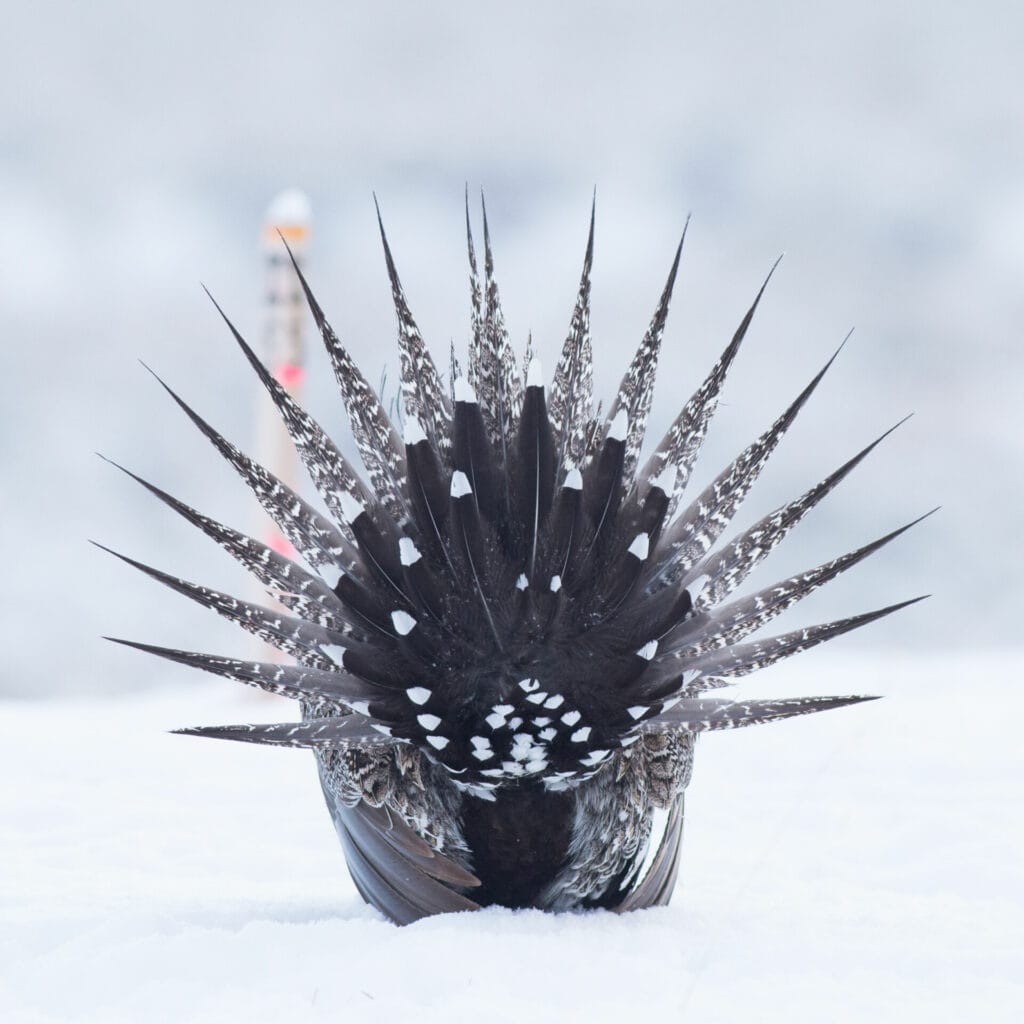
When they are displaying, each male Greater Sage-Grouse shows a distinctive pattern of white feather tips on their undertail covert feathers. We affectionately called this their “buttprint” (like a fingerprint, but… well, you get the idea). We took photographs of the males facing away from us, then processed the photos to pull out the white spots. Our field crew could then use this library of patterns to identify each male on the lek, similarly to how whale researchers use fluke coloration or giraffe experts look at coat patterning to track individuals. The method has its limitation for Greater Sage-Grouse since it requires the males to raise their tails and doesn’t work as well in windy conditions that blow their feathers around. Unfortunately the males molt these feathers so we can’t use buttprints to follow untagged males year after year.
Even after spending more than a decade with the Greater Sage-Grouse, every morning I spent huddled in a freezing blind photographing a lek was special. I still can’t believe how fortunate I was to get a front-row seat to such amazing bird behavior and that my photographs and observations were so directly impactful to our research.
Alan is a biologist and photographer living in Richmond. He is broadly interested in evolution, ecology, and natural history. Most of his research has focused on the behavioral ecology of birds. To learn more about Alan’s life and work, you can go to his WEBSITE. Alan also has a Nature PHOTOGRAPHY WEBSITE, complete with his lovely photographs.
